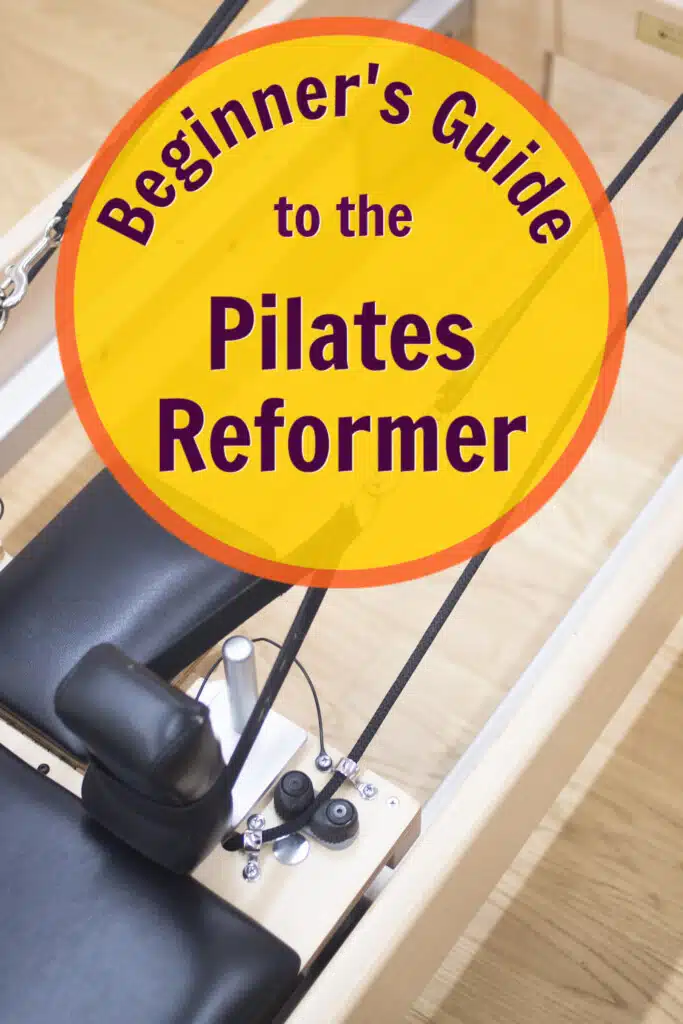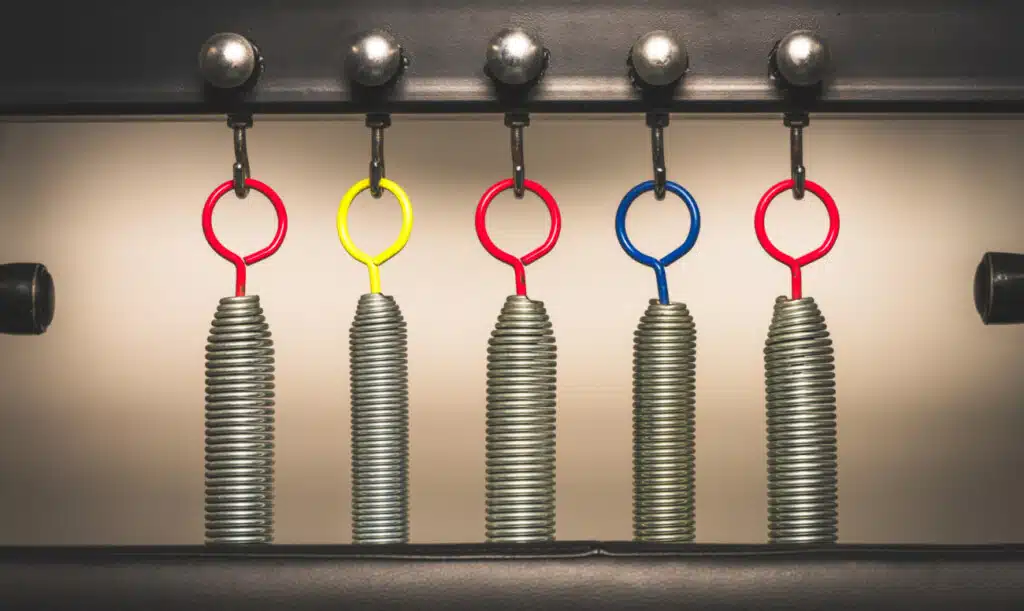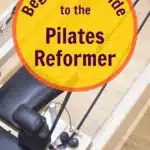Pilates can give you a healthier body that looks and feels better. These exercises might be the perfect fitness regimen for you, especially if you like the idea of strengthening your core, improving your posture and flexibility, and enhancing your overall body strength. In this beginner’s guide, I reveal one of the most versatile, effective, and popular pieces of equipment in Pilates: the reformer.
I’ve included a video lower within this article that should prove helpful.
Welcome to Pilates! What Beginners Need to Know about the Reformer
Welcome to the world of Pilates! Here’s what you need to know about the reformer, which is a sliding bed within a frame – equipped with various attachments:
- Carriage: the sliding platform “bed” that moves back and forth on the frame.
- Springs: the reformer provides adjustable resistance, making it suitable for all fitness levels. The springs are the source of this resistance, allowing you to adjust the intensity of your workouts.
- Straps and Handles: attached to the top end of the carriage, these are used for both upper and lower body exercises.
- Footbar: positioned at the bottom end of the reformer, the footbar is used to push against (or pull from) during certain exercises.
Benefits of Reformer Pilates for Beginners
The reformer is fun to use. I think its enjoyability is probably the biggest reason that such an odd-looking piece of equipment is still wildly popular over 100 years after being invented.
I’ve been doing Pilates for 40 years, and the primary reason I’ve stuck with it all this time is that it gets results and is fun.
Speaking of results, the reformer offers numerous advantages over mat-based Pilates exercises. I’m sharing a few key benefits:
Versatility: The reformer allows for a wide range of exercises that target different muscle groups and movement patterns.

Increased resistance: The adjustable springs provide resistance, challenging your muscles and improving overall strength.
Improved alignment and posture: The reformer promotes proper alignment, helping to correct imbalances and improve posture.
Enhanced core engagement: The moving carriage demands increased core stabilization, leading to a stronger and more stable midsection.
Beginner’s Mind: Getting Started on the Pilates Reformer
“Beginner’s mind” is a psychological concept that encourages an attitude of open curiosity, receptivity, and non-judgment towards experiences and knowledge. So, even if you’ve been working out for years, it can be helpful to approach your new Pilates practice with a fresh perspective – free from preconceived notions or the limitations of past exercise modalities:
- This attitude shift allows you to achieve a deeper level of understanding, growth, and the potential for new insights and possibilities as your Pilates practice emerges.
- I encourage you to embody a beginner’s mind to cultivate your sense of wonder and willingness to explore and learn. Remember, Pilates can be a lot of fun if you stay open-minded!
You want a safe and effective Pilates practice, so I invite you to find a qualified instructor. Look for one who has experience teaching on the reformer – the more experience, the better.
Even if you’ve purchased a reformer for your home gym, it’s still wise to have at least a few initial sessions with a Pilates coach to help give you a safe and solid foundation. You’re more likely to have successful practice that way.
If you want to take your Pilates practice to the next level, a reformer machine can be a great investment. But it’s also fun to use a Pilates coach at your favorite local studio, so whatever works for you. (After years of taking mat classes and private lessons at Pilates studios, I purchased my own reformer and put it in my home gym. For me, almost ten years later, it remains a rewarding and smart decision.)
While it may seem daunting at first, with the right guidance and practice, you can use the reformer to enhance your Pilates routine and achieve greater strength, flexibility, and balance – and a better-looking body!
Beginner’s Tips for Your First Reformer Session
Before your first reformer session, keep the following tips in mind:
- Wear comfortable workout attire that allows for unrestricted movement.
- Avoid wearing loose jewelry or clothing that may get caught in the equipment.
- Bring a towel and water bottle to stay hydrated during your workout.
Before your first session, take a few minutes to familiarize yourself with the reformer. Your instructor will guide you, but here are some basics to understand:
- The carriage moves back and forth on the frame.
- The springs can be adjusted to increase or decrease resistance.
- The footbar can be positioned at different heights to accommodate various exercises.
Pilates can seem like yoga in the sense that form and technique are always your top priorities!
When using a Pilates reformer, it’s important to focus on proper alignment and form to avoid injury and get the most out of your workout.
Keep your shoulders relaxed away from your ears, engage your core, and maintain a neutral spine throughout each exercise. Make sure your feet, knees, and hips are in proper alignment and avoid locking your joints.
As you advance in Pilates, the specific exercises are important, but so are the transitions between exercises. The speed and form you demonstrate when transitioning from one exercise to another are also a part of the Pilates experience. If you ever watch a true Pilates athlete, you will notice that their transitions are as meticulous and focused as the rest of their workout.
Essential Reformer Exercises for Beginners
First, you’ll want to learn the basic exercises.
Some of the most common exercises include the footwork series, the leg circles, and the long box series.
Some tips for having a good experience: anytime you’re in a plank (push-up) position, try to keep your wrists slightly in front of your shoulders (shoulders coming in front of wrists are only for people who are genetically very flexible). Also, be mindful that your quadriceps (the large muscles in the front of your upper thighs) are comparatively powerful and will hog all the work from the other muscle groups if you let them. Instead, imagine initiating most movements from your core muscles.
Footwork
Footwork is an excellent exercise to start with, as it helps you get comfortable with the movement of the carriage. Here’s how to perform it:
- Lie on your back with your feet on the footbar – knees bent.
- Press your feet against the footbar and push the carriage away, straightening your legs.
- Slowly bend your knees to bring the carriage back to the starting position.
- Repeat for 8-10 reps, focusing on maintaining proper form and engaging your core.
- Finish with single-leg squats and heel raises for your calves if you’re feeling adventurous.
- SEQUENCE: first-position, bird birch, flexed, single-leg, heel raise.
Feet in Straps: Frog and Leg Circles
Frog and leg circles engage your core, hips, and legs while challenging your balance and stability. Follow these steps to perform leg circles:
- Put your feet in the straps.
- Lie on your back with your legs extended vertically toward the ceiling, heels together, and feet flexed.
- Begin frogs by doing “plié” in First Position (heels stay together, legs turned out). Do 12 reps.
- Next, begin circles with toes pointed.
- Circle your legs, keeping your hips stable and engaging your core.
- Complete 5-8 circles in one direction and then reverse the direction for an equal number of circles.
- Focus on controlled movements and maintaining a neutral spine throughout the exercise.
Long Box Series
Time to condition your upper body! In the video, you’ll see me demonstrating:
- Strap pull-through.
- Strap lat pull: “wings.”
- Tricep kickback.
- Bicep curl with static crunch.
- Backstroke with lower ab leg lift.
Try 8 to 12 reps for each exercise to start.
Short Box Series
Designed to toast your core, these exercises will strengthen your abdominal muscles in ways you can see and feel:
- Sit-up: fully compressed.
- Sit-up: lengthened.
- Sit-up: oblique rotation.
Try 8 to 12 reps for each exercise, to start.
Modified Planking (from the Long-Stretch Series):
- Mobile plank: hands on the footbar, feet together on the headrest.
- Reverse mobile plank: feet on the footbar, hands on the shoulder pads.
- With alternating leg lift.
Try 8 to 12 reps for each exercise to start.
Beginner’s Progression to Intermediate
Start with these basic exercises and gradually work your way up to more advanced movements as you become comfortable with the machine.
Like any fitness endeavor, consistency and practice are key to achieving results. Here are some tips to further progress your practice on the Pilates reformer and gradually increase the difficulty of your workouts:
Use the Springs to Adjust Resistance on Your Pilates Reformer
One of the unique features of a Pilates reformer is the use of springs to adjust resistance.

The springs provide varying levels of tension, allowing you to customize your workout and target specific muscle groups.
The heavier the spring, the more resistance you’ll feel.
Start with lighter springs if you’re a beginner, and gradually work your way up to heavier ones as you become more comfortable with the machine. Remember to adjust the springs as needed to avoid overexertion or injury. (Note: there are exercises where using lighter springs is actually harder than using heavier springs, but those exercises tend to come later in the intermediate and advanced series.)
Adding Variations, Advanced Exercises, and More Reps
Once you have mastered the foundational exercises, you can introduce more advanced movements and variations. These may include exercises like side splits, teaser, and knee stretch series (again, a qualified instructor can be very helpful in getting you to progress successfully in your Pilates practice).
You can also increase the number of repetitions for each exercise.
A friendly caution: it’s important to listen to your body and not push yourself too hard too quickly. Gradual progress is key to avoiding injury and getting the most out of your Pilates practice.
If any exercise in the video below is too difficult at this early stage, or if you experience any pain, don’t do that exercise. I encourage you to get the all-clear from your doctor before beginning any new workout regimen.
Conclusion: Creating a Stellar Physique on the Pilates Reformer
Congratulations on taking the first step toward incorporating the reformer into your Pilates practice.
Following this beginner’s guide gives you a solid foundation to start using the reformer effectively.
Combining regular Pilates workouts with good nutrition and ample sleep can absolutely transform your body in the best ways possible.
Remember to work with a qualified instructor, practice proper form, and progress at your own pace.
Embrace the versatility of the reformer, enjoy your Pilates journey, and experience the profound benefits it offers for your mind and body.
Pilates reformer machines can look intimidating, but with this beginner’s guide, you’ll learn how to use them with ease and get the most out of your workout.
